- Serviced Accommodation Guide 2023
- TMC Guide 2023
- The Knowledge
- Speaking Out
- Talking Travel
- Diary of a CTO
- Accommodation
- Sustainability Specialists
- Business Travel People Awards 2023
- Events calendar
- Business Travel People Awards
- People Awards: Meet the winners
- Destinations

- Latest issues


McKinsey report predicts speed of business travel recovery

Worldwide business travel spending looks set to rise by more than a quarter this year and reach two thirds of pre-pandemic levels by the end of 2022.
This is the forecast in a report from the World Travel & Tourism Council in collaboration with McKinsey & Company published this week.
Based on research, analysis and in-depth interviews with travel and tourism business leaders, the report is designed to help organisations prepare for corporate travel post pandemic.
It predicts a modest 26% rise in global business travel spend this year followed by a further rise of 34% in 2022.
But this comes in the wake of a 61% collapse in business travel spend in 2020 due to the pandemic restrictions.
The report predicts that the Middle East will lead the revival, with business spending set to rise by 49% this year (stronger than leisure spending at 36%) followed by a 32% rise next year.
In Asia Pacific, business spending is expected to climb by 32% this year and by 41% in 2022.
Spending in Europe is predicted to rise by 36% this year (stronger than leisure spending at 26%), followed by a 28% increase next year.
Meanwhile Africa spending is set to rise by 36% this year and 23% next year and in the Americas by 14% this year and by 35% in 2022.
Julia Simpson, WTTC CEO & President, said: “Business travel is starting to pick up. We expect to see two thirds back by the end of 2022.
“Business travel has been seriously hit but our research shows room for optimism with Asia Pacific and Middle East first off the starting blocks.”
The report said global business travel has been more significantly hit than leisure travel, with business spending falling by 61% compared to a 49% drop in leisure spending.
It quoted Kurt Ekert, former President and CEO of Carlson Wagonlit Travel, who told researchers: “The impact has been profound, and on business travel has been even more substantive than on overall travel. In fact, business travel was still down 80% [in our organisation] 12 months into the pandemic.”
To speed up the recovery of business travel, the report recommends businesses “adjust their revenue models, expand geographic focus and improve digital services”.
It said the shared challenge of restoring business travel would also depend on ongoing collaboration and partnerships across the private and public sectors and nurturing new relationships.
Eurostar revamps classes and fares
Itm: online booking tools not meeting buyer requirements, hilton debuts zero-waste menus, play airlines debuts flights to wales, related articles, direct travel expands executive team, more than a magazine.
For everyone involved in booking, buying, managing or arranging business travel and meetings.
OTHER TITLES
The Business Travel Magazine is published by BMI Publishing Ltd: 501 The Residence, No. 1 Alexandra Terrace, Guildford, GU1 3DA. Tel: 020 8649 7233
© BMI Publishing Plugged In Media
- Marketplace
- Marketplace Morning Report
- Marketplace Tech
- Make Me Smart
- This is Uncomfortable
- The Uncertain Hour
- How We Survive
- Financially Inclined
- Million Bazillion
- Marketplace Minute®
- Corner Office from Marketplace

- Latest Stories
- Collections
- Smart Speaker Skills
- Corrections
- Ethics Policy
- Submissions
- Individuals
- Corporate Sponsorship
- Foundations
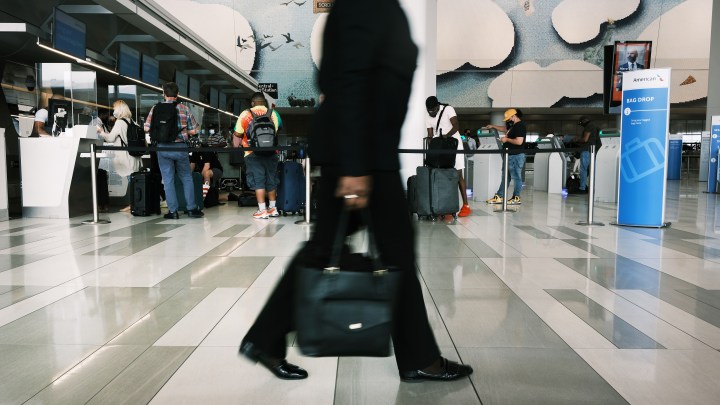
Business travel is coming back, but it looks different
Share now on:.
- https://www.marketplace.org/2022/07/21/business-travel-is-coming-back-but-it-looks-different/ COPY THE LINK
HTML EMBED:

Get the Podcast

- Amazon Music
If you’re looking for proof that, at least psychologically, we are mostly over the pandemic, look toward the skies.
On Wednesday, United Airlines reported more than $12 billion in revenue for the prior quarter, the most money the company has made in over a decade. Thursday, American Airlines told investors it made its first quarterly profit since the pandemic hit.
Those companies’ planes are mostly packed with pent-up demanders for vacation travel. But a more lucrative passenger is also returning to the skies: the business traveler.
Justin Strelow is generally thrilled to be traveling for business again. Although he’s not thrilled with every part of it.
“I do not eat at the airport. I am trying to drop a few pounds,” Strelow said. “I’m trying to drop my pandemic weight.”
Strelow is a co-founder of Insysiv, a Kansas City, Missouri-based company that makes software for hospital labs. In two weeks’ time, Strelow will be flying himself and three employees to Anaheim, California, for a trade show. Even without airport Cinnabons, the trip will cost his small business around $15,000.
“I am still kind of old school. I like face-to-face with folks,” Strelow said. “We’ve found the value of getting in front of people in person and really solidifying those relationships.”
That is music to the airline industry’s ears. Before the pandemic, business travel accounted for more than 50% of profits, said Ryan Mann with the consulting firm McKinsey.
“Business travelers tend to book at the last minute, and that’s when prices are the highest,” Mann said.
Business travel is about 70% of where it was in 2019, according to the aviation data company Arc.
Mann said Zoom has replaced smaller in-person meetings that used to involve travel, “but conferences, frankly, are filling the gap.”
As are corporate retreats and team-building trips where remote employees can finally see how tall their co-workers are.
While business travel is trending up, it’s an open question whether it will ever recover fully. A recession could make that more difficult.
“That’s an area where they can cost cut, and there’s a clearly proven alternative in Zoom,” said Chris Raite, an analyst at the investment research firm Third Bridge.
Plus, you don’t have to worry about your Zoom getting delayed because of a pilot shortage.
Stories You Might Like

With Americans itching to travel, the second new low-cost airline this year is taking to the skies
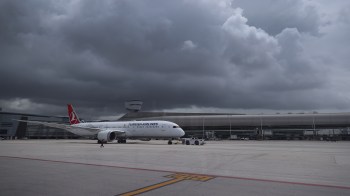
Travel slowing as Labor Day nears
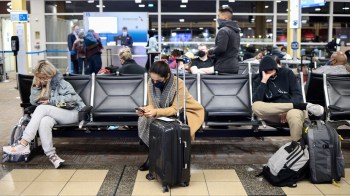
The travel industry is still feeling the loss of business customers

Airlines, struggling with COVID-19 headwinds, tally their 2020 financial losses

As people start flying again, more are exploring the first-class cabin

A new airline is launching, focusing on smaller airports
There’s a lot happening in the world. Through it all, Marketplace is here for you.
You rely on Marketplace to break down the world’s events and tell you how it affects you in a fact-based, approachable way. We rely on your financial support to keep making that possible.
Your donation today powers the independent journalism that you rely on . For just $5/month, you can help sustain Marketplace so we can keep reporting on the things that matter to you.
Also Included in
- Airline industry
- Business travel
Latest Episodes From Our Shows

The TikTok ban is poised to make the U.S.-China divide even starker

The WIC family food program is getting a refresh, but requirements are still tough to navigate

Why does the world want dollars? Because of high interest rates, thriving economy in U.S.

Recent college grads see rise in unemployment

McKinsey’s insights into the return of corporate travel
by Jeff Weinstein
July 8, 2021 - Categories: Hospitality News, Hotels: News,
As businesses start to bring employees back to offices and in-person meetings and events are in the offing, management consultancy McKinsey & Co. sees 80% of corporate business travel volume to return by 2023 (or a 20% reduction of corporate trips by 2023). In a new report , it identified four categories of business travelers and suggested how key players in the travel space can best prepare to for this next phase.
McKinsey discusses the COVID-related changes made in corporate cultures and goes into detail about these four travel groups – the “never left,” the “never returning,” the “fear of missing out” (FOMO), and the “wait and see” segments.
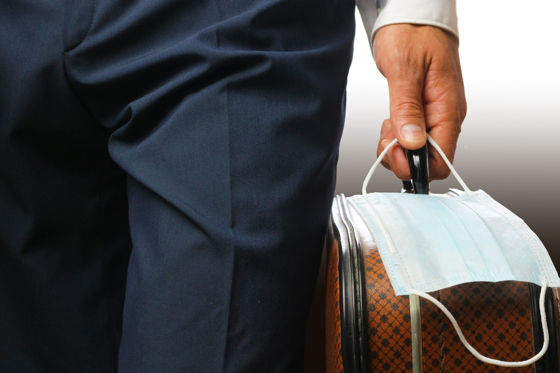
In a recent survey, around 30% of executives say they have not heard about specific plans for corporate travel after the pandemic, while another 28% described their companies’ plans as vague. With that in mind, it goes deeper into breaking down corporate trips into different segments to help travel planners and suppliers plan for the return of corporate travel.
The report further stated that key players in the ecosystem, including hoteliers, need to master four critical skills: leveraging real-time data, planning with agility, aiming for comfort and safety, and communicating with clarity.
Comment Cancel
You must be logged in to post a comment.
Privacy Overview
Access this content free on hotelsmag.com by logging in or registering now.
Username or Email Address
Remember Me
Username can contain any letters or numbers, without spaces
Please provide your E-mail
Password should be at least 4 characters
Please confirm password
HOTELS News and Views
Hotels week in review, hotels magazine.
- Share full article
Advertisement
Supported by
McKinsey Is Under Criminal Investigation for Its Opioid Work
Federal prosecutors are examining the consulting company’s role in helping “turbocharge” the sale of painkillers like OxyContin.

By Glenn Thrush , Michael Forsythe and Walt Bogdanich
Glenn Thrush covers the Justice Department for The Times. Michael Forsythe and Walt Bogdanich, authors of “When McKinsey Comes to Town,” have been reporting on the consulting firm for years.
The Justice Department is investigating McKinsey & Company, the international consulting giant, for its role in helping drug companies maximize their sale of opioids.
The investigation is led by the U.S. attorneys’ offices in Massachusetts and the Western District of Virginia in coordination with the department’s civil division in Washington, according to two officials familiar with the case who spoke on condition of anonymity.
Since 2021, McKinsey has agreed to pay about $1 billion to settle investigations and lawsuits across the United States related to the firm’s work with opioid makers, principally Purdue Pharma, the maker of OxyContin. McKinsey recommended that Purdue “turbocharge” its sales of the drug in the midst of the opioid crisis, which has killed hundreds of thousands of Americans. McKinsey has not admitted any wrongdoing.
News of the criminal investigation was first reported by The Wall Street Journal on Wednesday.
The investigation has been underway for several years. Endo, a pharmaceutical company that hired McKinsey to advise on the sale of the opioid Opana, said in a regulatory filing that it received a subpoena in December 2020 from the Western District of Virginia seeking information about McKinsey. The New York Times reported on the existence of that subpoena in 2022. Last year another opioid maker, Mallinckrodt, said it received a grand jury subpoena from the same U.S. attorney’s office but did not mention any connection to McKinsey.
Federal prosecutors are also looking into whether McKinsey obstructed justice in its handling of records, according to The Journal.
By 2018, senior McKinsey consultants were growing increasingly worried that they might be held to account for their opioid work. On July 4 of that year, Martin Elling, a leader in the firm’s pharmaceutical practice, made a decision he would later regret. He sent an email to Arnab Ghatak, a senior partner, asking whether they should eliminate documents and emails connected to opioids.
Mr. Ghatak replied: “ Thanks for the heads up. Will do .”
Both men were fired after The Times reported in 2020 about the existence of the emails.
It isn’t unusual for criminal investigations like this to go on for many years, especially ones involving two U.S. attorneys’ offices, the Justice Department and possibly state agencies as well, Rick Mountcastle, a former federal prosecutor, said.
He led a criminal investigation into Purdue Pharma that resulted in the company’s guilty plea in 2007 to having misled regulators, doctors and patients about the dangers of OxyContin. “It is a huge monster bureaucracy that moves at a very slow pace,” said Mr. Mountcastle, who was not a source confirming the existence of the investigation.
McKinsey made about $86 million over many years advising Purdue Pharma. The bulk of that work took place after Purdue’s guilty plea. In 2019, McKinsey said it would no longer advise clients on opioid-related business.
Ramiro Prudencio, a spokesman for McKinsey, declined to comment. A spokesman for the Justice Department had no comment on the case.
Glenn Thrush covers the Department of Justice. He joined The Times in 2017 after working for Politico, Newsday, Bloomberg News, The New York Daily News, The Birmingham Post-Herald and City Limits. More about Glenn Thrush
Michael Forsythe a reporter on the investigations team at The Times, based in New York. He has written extensively about, and from, China. More about Michael Forsythe
Walt Bogdanich joined The Times in 2001 as investigative editor for the Business desk. Since 2003, he has worked as an investigative reporter. He has won three Pulitzer Prizes. More about Walt Bogdanich
- Skift Research
- Airline Weekly
- Skift Meetings
- Daily Lodging Report
New Research
Just published.

Skift Travel Health Index
Skift travel health index: march 2024 highlights.
The Travel Health Index in March 2024 shows an overall softening trend compared to the previous month, with the index dropping by 4 pp. However, some countries continue to showcase robust growth, with China, Japan, and Hong Kong at the forefront with double-digit growth levels.
Latest Reports
Online Travel
A Deep Dive into Google Travel Part III: Hotel Distribution From East to West

Consumer Habits
Tying the Knot Abroad: Market Sizing Indian Wedding Tourism


The Opportunity for Long-Haul, Low-Cost Airlines

Skift Travel Health Index: February 2024 Highlights

Free Access

Will Hotel Pricing Strength Continue into 2024?
As we enter 2024, where inflation growth is expected to further ease off and we largely move away from Covid-era economic trends, the big question in the hotel industry remains: will pricing strength continue into 2024?
Skift Travel 200 by Sector
The Skift Travel 200 combines the financial performance of nearly 200 travel companies worth more than a trillion dollars into a single number. The ST200 makes it easy to track travel industry performance for the first time ever.
Learn more about the ST200 by reading our full methodology .
View by Sector
- Accommodations
- Travel Tech
- Cruise and Tours
- Ground Transport
Most Read This Month

Exploring Gen Z and Millennial Travel Habits
Millennials and Gen Z are steering travel trends with a focus on technology, sustainability, and a quest for distinctive and meaningful experiences.

Hotel Tech Benchmark: Payment Solutions 2023
The pandemic accelerated the shift to digital and alternative payments. To capitalize on this, hoteliers should modernize their payment tech stack to offer seamless integration and diverse payment options for increased bookings, higher-value reservations, and improved guest satisfaction.

Skift Research Global Travel Outlook 2024
2024 will be the year that the travel industry fully transitions from catch-up to true growth above pre-pandemic levels. Without revenge travel as a tailwind we expect a more normal growth trajectory for the travel industry this year.

Navigating Q4 2023: Analysing the Value of Travel Credit Cards in the U.S.
Younger Demographics Drive Growth in U.S. Travel Credit Card Market, Bank Brands Dominate

Generative AI’s Impact on Travel
Generative AI is poised to transform the travel industry. True, there’s plenty of hype out there with little substance to back it up. But even after Skift Research separates the chaff from the wheat, we find that a multi-billion dollar opportunity still remains.

The Past, Present, and Future of Online Travel
The golden era of Booking and Expedia is facing challenges of slowing growth and increased competition, prompting a fierce battle for market share through innovation and expansion efforts amid a changing landscape.
Skift Research – McKinsey & Co.

The Promise of Travel in the Age of AI
This new report in collaboration with McKinsey & Co. is intended to inspire travel companies to reimagine their businesses, raise the industry’s aspirations, and unlock long-term stability and growth through the use of AI.
August 2023 Highlights
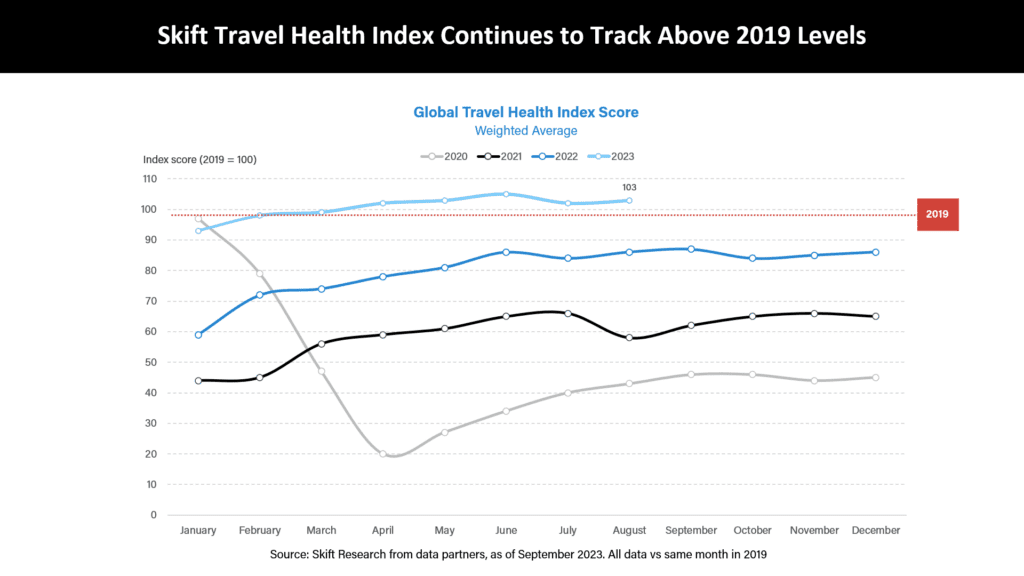
Find out how the travel industry is performing across the globe.
Book an Analyst for Your Event
Subscribe to Skift Research
- 3+ new reports per month
- Access to 200+ reports
- Analyst Q&As through email
- 25% off tickets to Skift Forum events
- Quarterly analyst report review calls
- High resolution PDFs of new reports as they're released
Ex-McKinsey partner sues firm, claims he was made opioids 'scapegoat'
- Medium Text
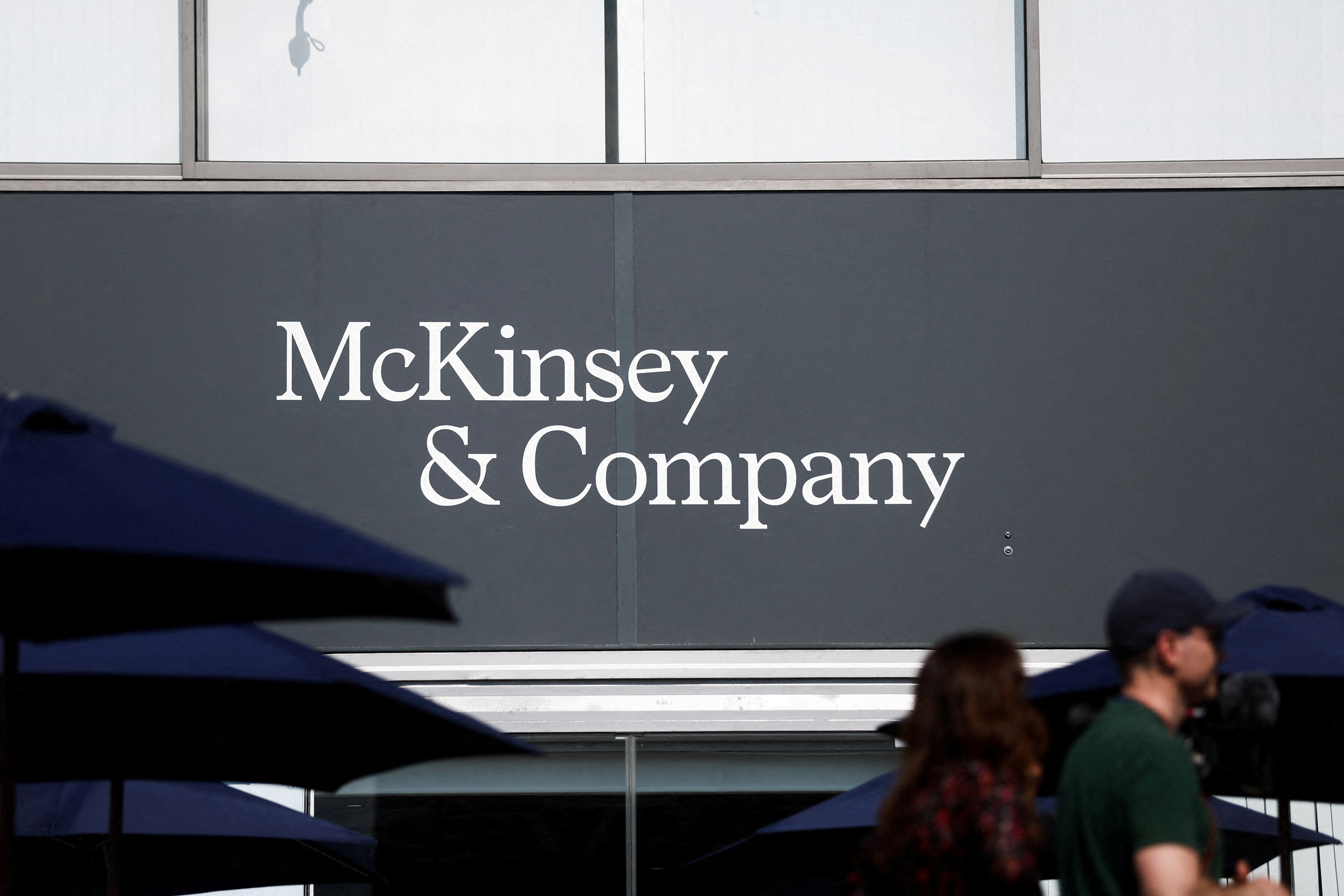
- Company Mckinsey and Company Inc Follow
- Company Purdue Pharma LP Follow
Sign up here.
Reporting by Nate Raymond in Boston; additional reporting by Chris Prentice; Editing by Leslie Adler
Our Standards: The Thomson Reuters Trust Principles. New Tab , opens new tab

Thomson Reuters
Nate Raymond reports on the federal judiciary and litigation. He can be reached at [email protected].

Business Chevron
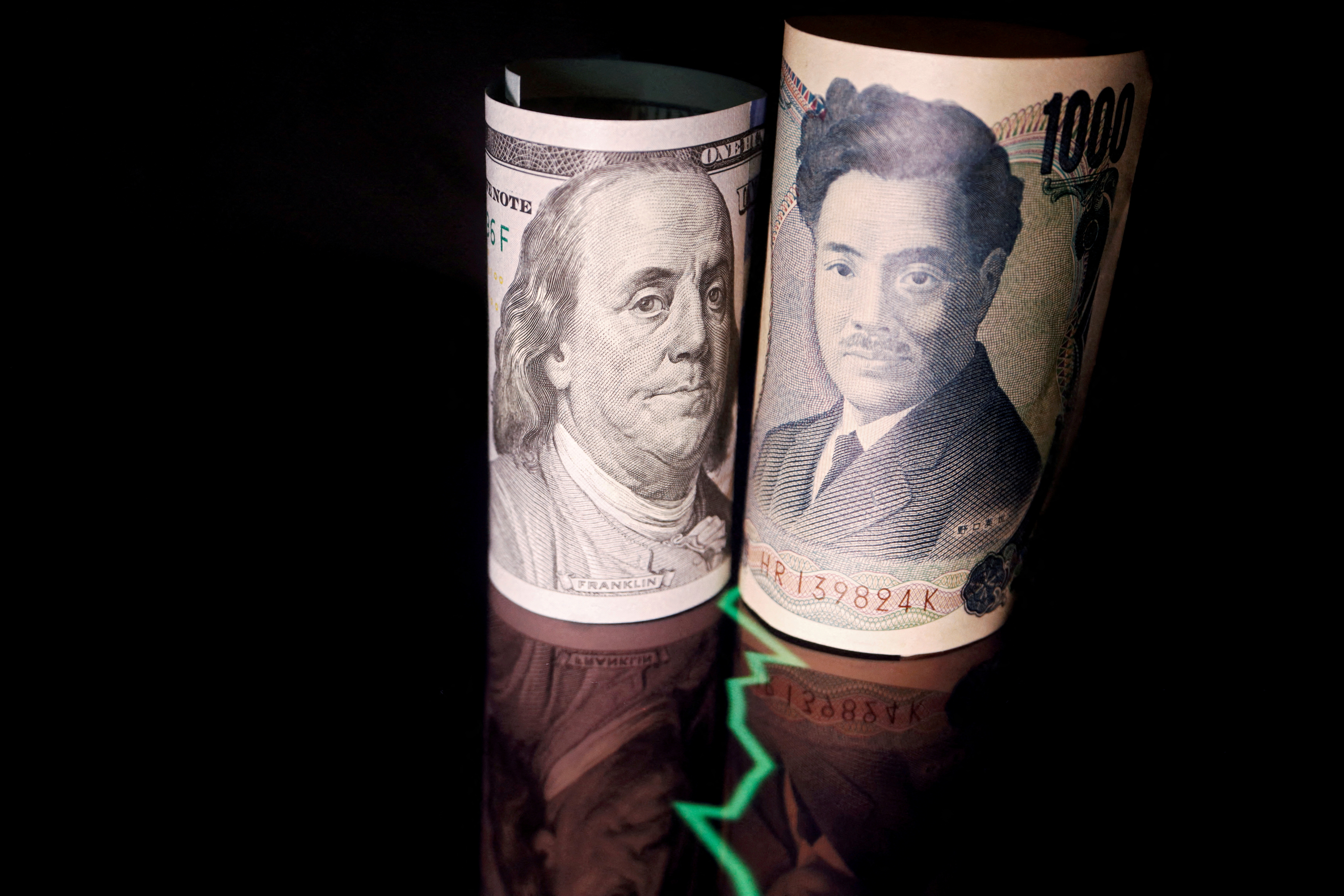
Instant view: Japan's yen jumps against the dollar after earlier plunge
The yen jumped suddenly against the dollar on Monday, with traders citing yen-buying intervention by Japanese authorities to try to underpin a relentless tumble in the currency to levels last seen over three decades ago.

Global Economics Intelligence executive summary, March 2024
Despite global uncertainty fueled by geopolitical and economic concerns, consumption among surveyed economies is holding up strongly, except in the eurozone. This is encouraging given that consumer confidence globally looks somewhat downbeat, with the OECD indicator trending below the long-term average and dipping downward. That said, consumer confidence in the majority of surveyed economies is oscillating just below the average, while Brazil is more positive. Consumer confidence in Brazil has reached its highest level so far this year and is 4.0 points higher than in March 2023. Confidence rose 1.6 points to 91.3 in March, from 89.7 in February, though remaining below the neutral 100 mark. The US consumer confidence index (Conference Board) fell to 106.7 in February, down from a revised 110.9 in January.
Meanwhile, US retail and food service sales climbed to $700.7 billion, a 0.6% increase from January’s $700.2 billion. The Society of Indian Automobile Manufacturers’ March 2024 data shows a decline in auto sales for February, down –5.7% versus the prior month to 370,786 (393,074 in January)—auto sales are a proxy for retail sales. In Russia, retail sales have stayed virtually unchanged for several months. Private consumption is expected to remain the main growth engine in coming months, driven by increasing incomes.
Overall, looking at the trend in consumer spending habits since the global pandemic, it is worth noting that, while spending has rebounded post-COVID-19, around a quarter of consumer spending categories remain below their December 2019 levels.
A rosier picture is painted by the latest McKinsey Global Survey on economic conditions. 1 “ Economic conditions outlook, March 2024 ,” McKinsey, March 29, 2024. Respondents have increased confidence in the economy—both globally and at home. Notably, respondents share much brighter assessments of both the global economy and conditions in their own countries than they did at the end of 2023. Views of the global economy are the most positive they’ve been since March 2022 (Exhibit 1) and, in the majority of regions, respondents also have a more hopeful outlook on domestic conditions despite enduring concerns over geopolitical instability and conflict.
However, in a year packed with national elections, executives are concerned about political uncertainty—increasingly viewing transitions of political leadership as a primary hazard to the global economy, particularly in Asia–Pacific, Europe, and North America. They view policy and regulatory changes as a top threat to their companies’ performance, and they offer more muted optimism than in December about their companies’ prospects.
Consumer inflation eased to around 2–3% among advanced economies (Exhibit 2) and producer prices remain subdued. In the emerging economies, inflation remains under control despite increasing inflationary pressures. In the US, the consumer price index rose 3.2% (annualized) in February, slightly higher than the 3.1% for the 12 months ending January. By contrast, eurozone headline inflation fell slightly to 2.6% year-over-year in February, down from 2.8% in January. The UK surprised forecasters as the consumer price index fell by more than expected to 3.4% in February, its lowest rate since September 2021.
Among the emerging economies, India’s headline inflation was unchanged at 5.1% in February. In Brazil, inflation fell slightly to 4.50% (4.51% in January), registering a fifth consecutive month of reduction, to touch the upper limit of the central bank’s target inflation range (4.5%). It’s a different story in Russia, where inflation has continued to accelerate in recent months: consumer prices rose by 7.7% year-over-year in February, reflecting tightening capacity constraints.
Looking ahead, inflation expectations have edged up but remain within the 2.0–2.5% range.
It’s a mixed picture for commodities: precious metals and livestock are surging, with gold growing steadily into March, while agricultural prices are declining and other commodities are generally stable. A recent uptick in oil prices can be attributed to reduced stocks, while other energy-related commodity prices are trending down. Base metal prices have been moving sideways for more than a year. The cost of food around the world continues to ease but remains close to 20% above prepandemic levels.
Interest rates were once again largely unchanged, with Brazil being the exception. On March 20, the Central Bank’s Monetary Policy Committee decided to cut the Selic rate by another half a percentage point, to 10.75%.
In terms of GDP, Europe is underperforming compared with many areas. During the last quarter of 2023, eurozone GDP remained stagnant, marginally up by 0.1% on both the prior quarter and the same period in 2022, according to Eurostat flash estimates (meaning that 2023 as a whole saw growth of 0.6%). Moreover, UK real GDP is estimated to have fallen –0.1% in the three months leading to January 2024, versus the three months leading to October 2023. Services output showed no growth during this period, while production output fell –0.2%. In Russia, monthly indicators for January suggest that growth in economic activity has slowed. Meanwhile, India’s real GDP growth surged to a six-quarter high of 8.4% in the third quarter of the 2023–24 fiscal year, while China’s government has set a GDP growth target of around 5.0% for 2024.
The global purchasing managers’ index (PMI) is seeing manufacturing growth return in many places, while services are gaining momentum. In the US, the manufacturing PMI rose to a 21-month high of 52.5 in March (47.9 in December), while India’s manufacturing PMI reached a five-month high of 56.9 in February 2024, up from 56.5 in January. However, the eurozone and UK manufacturing sectors are continuing to contract on the basis of weak demand. February’s composite PMI for the eurozone edged up to 49.9, from 49.2 in February, to record a nine-month high. The manufacturing PMI fell marginally to 45.7, from 46.5. The UK manufacturing PMI strengthened slightly in February, posting 47.5 (up from 47 in January)—now below the neutral 50.0 mark for 19 successive months.
By contrast, the services sector expanded across all surveyed economies in February, with India the standout performer across January and February. In India, the services PMI moderated to 60.6 while still indicating robust expansion. Brazil saw its services PMI climb to 54.6 in February, from 53.1 in January, hitting a 19-month high, with new business increasing at the fastest pace since October 2022. The UK’s services PMI registered 53.8 in February, down from 54.3 in January but remaining in the expansion zone for the fourth consecutive month. In the US, the services PMI rose to 52.3, while the eurozone’s services PMI was up to 51.1 from 50.2, a nine-month high.
Unemployment has been growing moderately in recent months. The all-India unemployment rate was 8% in February, up by 1.2 percentage points on the previous month. In Brazil, the three-month moving average unemployment rate slightly rose to 7.6% in January (7.4% in December), up for the first time in 12 months. Meanwhile, China’s overall surveyed urban unemployment rate has increased for three months in a row, to 5.3% in February (5.2% in January). The youth unemployment rate climbed to 15.3% in February (14.6% in January). The US saw February’s unemployment rate rise to a two-year high of 3.9%. The UK unemployment rate was estimated at 3.9% in the period from November 2023 to January 2024. Perhaps more significant for the UK is a 21.8% economic inactivity rate for those aged 16 to 64, higher than estimates of a year ago (November 2022 to January 2023) and also up on the latest quarter. Russia’s situation is somewhat different, with unemployment at an all-time low for the post-Soviet era (3% in December 2023), driven by negative population growth and emigration—around 900,000 people have left the country due to the war in Ukraine and mobilization of reserves.
Most equities indexes showed gains for investors in February and March, with China an exception. The Shanghai stock index lost −0.7% and the Shenzhen index lost −1.2% in value by March 27 compared with levels at the end of February. Volatility eased across multiple assets, including gold, oil, and the euro-dollar exchange rate outlook. Government bonds continued to follow recent months’ upward trend, with the exception of those in Brazil, China, and India.
World trade has been slowing, though US exports were $0.3 billion up from December, at $257.2 billion; January imports were $324.6 billion, $3.6 billion above December’s imports. The total deficit climbed 5.1%, to $67.4 billion. In China, cross-border trade slowed in February. Exports growth decelerated to 5.6% in February (8.2% in January) and imports growth fell to −8.2% in February (15.4% in January). In February, Brazil’s balance of trade registered a surplus of $5.4 billion, with exports totaling $23.5 billion ($26.9 billion in January) and imports reaching $18.1 billion ($20.5 billion in January). Among surveyed economies, the standout is India, which saw merchandise exports reach $41.4 billion in February 2024 (an 11-month high) to register 11.9% year-over-year growth. Merchandise imports expanded further to $60.1 billion, with year-over-year growth of 12.2%. The merchandise trade deficit widened from $16.5 billion in January 2024 to 18.7 billion in February as imports outpaced exports growth. In some ways, it’s business as usual for Russia: preliminary Central Bank of Russia figures indicate that Russia’s current account surplus recovered in January from a December dip. Its current account surplus has averaged around $5 billion in recent months, roughly the same as in an average month during 2017–18.
Notable from the full report
In the advanced economies, the US saw inflation linger; eurozone GDP remained stagnant; UK inflation fell by more than expected to 3.4% in February.
United States. The consumer price index rose 3.2% (annualized) in February, a slightly higher increase than the 3.1% for the 12 months ending January. Core inflation was 3.8% (annualized) in February. The January 2024 Survey of Consumer Expectations from the NY Fed shows that one-year-ahead inflation expectations were unchanged at 3.0% after reaching the lowest level recorded since January 2021.
Eurozone. During the last quarter of 2023, eurozone GDP remained stagnant, marginally up by 0.1% on both the prior quarter and the same period in 2022, according to Eurostat flash estimates. That means 2023 as a whole saw growth of 0.6%. Even though economic activity has stagnated, some forward-looking indicators point to a pickup in growth further ahead.
United Kingdom. The UK Consumer Price Index fell by more than forecast to 3.4% in February 2024, its lowest rate since September 2021, mainly driven by a slowdown in food and restaurant price inflation. Core inflation, which excludes items such as energy, food, alcohol, and tobacco, fell to 4.5%—down from 5.1% in January. Services CPI also declined but remains elevated, at 6.1%.
Among emerging economies, China presented a mixed performance; India’s PMIs are buoyant; Brazil cuts interest rates again; growth slows in Russia.
China. The slowdown in the real estate market continued during the first two months of the year. On the demand side, floor space sold in new residential properties declined −28.6% (−25.8% in December), and average new home prices dropped −1.6% (−0.9% in December). On the supply side, floor space fell −30.6% across January and February combined (−13.3% in December).
India. The purchasing managers’ index (PMI) for manufacturing reached a five-month high of 56.9 in February 2024, up from 56.5 in January, supported by rising investments in technology, efficiency gains, and sales growth. The services PMI moderated to 60.6—though it still indicated robust expansion. The services sector accounts for more than 50% of India’s GDP.
Brazil. The Central Bank’s Monetary Policy Committee decided on March 20 to cut the Selic rate by another half a percentage point, to 10.75%. The Committee reinforces the need to persist with a contractionary monetary policy until the disinflationary process consolidates and inflation expectations anchor around the Committee’s targets. Inflation expectations stand at 3.5% for 2024. The Committee emphasized that progress in the easing cycle will depend on inflation dynamics and signaled further reductions of the same magnitude going forward.
Russia. Monthly indicators for January suggest that growth in economic activity has slowed. Manufacturing output and retail sales have remained virtually unchanged for several months, while the long stretch of construction growth appears to have ended in January. Private consumption is expected to remain the main growth engine in coming months, driven by increasing incomes.
McKinsey’s Global Economics Intelligence (GEI) provides macroeconomic data and analysis of the world economy. Each monthly release includes an executive summary on global critical trends and risks , as well as focused insights on the latest national and regional developments. View the full report for March 2024 here . Detailed visualized data for the global economy, with focused reports on selected individual economies, are also provided as PDF downloads on McKinsey.com. The reports are available free to email subscribers and through the McKinsey Insights app . To add a name to our subscriber list, click here . GEI is a joint project of McKinsey’s Strategy & Corporate Finance Practice and the McKinsey Global Institute .
The data and analysis in McKinsey’s Global Economics Intelligence are developed by Jeffrey Condon , a senior expert in McKinsey’s Atlanta office; Krzysztof Kwiatkowski , an expert at the Waltham Client Capability Hub; and Sven Smit , a senior partner in the Amsterdam office.
The authors wish to thank Nick de Cent, as well as José Álvares, Cristina Barrantes, Marta Dabrowska, Juhi Daga, Darien Ghersinich, Ricardo Huapaya, Yifei Liu, Marianthi Marouli, Tomasz Mataczynski, Frances Matamoros, Jose Maria Quiros, Erik Rong, and Sebastian Vargas for their contributions to this article.
The invasion of Ukraine continues to have deep human, as well as social and economic, impact across countries and sectors. The implications of the invasion are rapidly evolving and are inherently uncertain. As a result, this document and the data and analysis it sets out should be treated as a best-efforts perspective at a specific point in time, which seeks to help inform discussion and decisions taken by leaders of relevant organizations. The document does not set out economic or geopolitical forecasts and should not be treated as doing so. It also does not provide legal analysis, including but not limited to legal advice on sanctions or export control issues.
Explore a career with us
Related articles.

Global Economics Intelligence executive summary, February 2024

An update on European consumer sentiment: Proceeding with caution

Global trade explorer
A Gen Xer who got $250,000 in student loans forgiven said he can now finally start saving for retirement — and consider his dream of studying in India
- Joel Lambdin, 49, received $250,000 in student-loan forgiveness in January.
- It's a result of the Education Department's one-time account adjustments.
- Lambdin said the relief would allow him to save for retirement and consider long-term dreams.

Joel Lambdin finished graduate school in 1998 — but as a professional musician, he was hardly making enough money to pay off his student loans and other bills.
So Lambdin, now 49, said his only option to make ends meet was to put his student loans in forbearance — in which he was not making payments but interest was still accumulating .
"It was just so that I could subsist, so that I could survive," Lambdin told Business Insider. "With the hope that at some point, I would be making enough money that I would be able to take them out of forbearance and start paying them down."
But he grew to realize that the only way he could make a significant dent in his student loans was by switching careers. He didn't want to do that because he loved working in music, so he decided to keep his larger student loan in forbearance and begin paying off his smaller loan with a lower monthly payment.
He continued making those payments until the pandemic pause on student-loan payments , at which point he and his wife started making a plan of action to tackle the larger debt once the pause ended. That led them to discover the Education Department's initiative allowing some borrowers a one-time account adjustment . It lets the department evaluate borrowers' accounts and update payment progress toward forgiveness on income-driven repayment plans and Public Service Loan Forgiveness, including any payments made during a forbearance period.
That account adjustment led to a letter Lambdin received on January 31, reviewed by BI, from his student-loan servicer Aidvantage. It said: "Congratulations! The Biden-Harris Administration has forgiven your federal student loan(s) listed below with Aidvantage in full."
For Lambdin, that letter meant his $249,255 outstanding student-loan balance was effectively wiped out.
"It had started to feel like my fate was being decided for me by the cold hand of finance," Lambdin said, "and that was a weight that I didn't realize was there until it wasn't there."
He added: "The feeling was much more like putting down a backpack that was really full of books that you got used to. And then you put it down, and you're like, 'Oh, man, that feels so much better.' It's more like that, rather than sort of a jump-for-joy kind of situation."
While Lambdin is still working to determine what exactly the relief will mean for him and his wife, he said, discussing retirement is "a much more present conversation now" because contributing to savings is viable after the relief. He can also begin to look into buying a home.
Related stories
The Education Department continues to cancel student debt through its one-time account adjustments, a process it plans to complete this summer. Most recently, the department wiped out $7.4 billion in student debt for 277,000 borrowers , some of whom benefited from the adjustments.
Beyond financial goals, Lambdin said the relief was also allowing him the freedom to pursue some of his long-term dreams, including taking a sabbatical to study with his meditation teacher in India.
"It's something that I wouldn't have been able to even consider doing if we had to pay off student loans, but without them, it's something that I can really seriously consider doing," he said. "And so those are the kinds of things that I think get really lost in the monetary side of the conversation about debt relief."
'I've been really lucky'
While Lambdin said he felt as though he earned the relief given his decades of payments, he recognized that it's not that easy for many other borrowers.
For example, as BI has previously reported , some borrowers who might qualify for relief through different repayment programs may not have gotten it yet because of paperwork backlogs and administrative errors. On top of that, funding for federal student-loan servicers is strained — meaning many borrowers face hourslong hold times and cannot get clear answers from customer service regarding their payment progress.
"There are some real horror stories out there, and I've been really lucky in that I haven't experienced the kinds of shenanigans that other people have experienced," Lambdin said. "So I actually feel very lucky that things have transpired the way they have."
Some of those horror stories include inaccurate payment projections and delayed billing statements . When it comes to student-loan forgiveness, some borrowers told BI that their servicer made a mistake with the forgiveness , reinstating their payments months later.
The Education Department has said it's aware of the challenges borrowers face and has established an accountability framework to punish servicers when they fail to fulfill their contractual obligations.
The department is also in the process of crafting its new plan for student-loan forgiveness — it recently released the draft text of the rules , which included relief for borrowers with unpaid interest and those who have been in repayment for at least 20 years.
As for Lambdin, he's still figuring out how to approach life without student debt hanging over his head. But now he can consider various options, and he can thank the loan forgiveness for that freedom.
"There's a certain amount of waiting for the other shoe to drop because it's not that I don't trust that it's happening but just that the debt has been with me for so long, and then it's not there," Lambdin said. "And it's something that I think really takes some getting used to."
Watch: Biden announces who can have $10,000 erased in student loans
- Main content

IMAGES
COMMENTS
It seems that, finally, the light at the end of the pandemic tunnel is in sight—at least in some parts of the world. In 2020, total global business travel expenses contracted by 52 percent, while managed corporate-travel spending in the United States plummeted 71 percent, or $94 billion. Last year, when we reported on the impact of COVID-19 ...
In the 2020 report, "The travel industry turned upside down," McKinsey & Company partnered with Skift Research to document the unprecedented impact that COVID-19 had on the travel sector. 1 Seth Borko, Wouter Geerts, and Haixia Wang, "The travel industry turned upside down: Insights, analysis, and actions for travel executives," September 22, 2021, McKinsey.com.
A McKinsey survey reveals traveling to be the second-most-desired activity among respondents (in first place: dining out). In the United States, air travel has hit two million daily passengers, closer to the prepandemic level of around 2.5 million than to the low of around 90,000, in April 2020. Hotel reservations and rental-car bookings are ...
McKinsey's most recent consumer survey, published in late October, found that countries with older demographics, such as France, Italy, and Japan, are less optimistic than are those with younger populations, such as India and Indonesia. ... In 2018, business-travel spending reached $1.4 trillion, which was more than 20 percent of the total ...
Travel fell sharply during the COVID-19 pandemic—airline revenues dropped by 60 percent in 2020, and air travel and tourism are not expected to return to 2019 levels before 2024. 1 "Back to the future? Airline sector poised for change post-COVID-19," McKinsey, April 2, 2021; "What will it take to go from 'travel shock' to surge? " McKinsey, November 23, 2021.
McKinsey report predicts speed of business travel recovery. Worldwide business travel spending looks set to rise by more than a quarter this year and reach two thirds of pre-pandemic levels by the end of 2022. This is the forecast in a report from the World Travel & Tourism Council in collaboration with McKinsey & Company published this week.
Before the pandemic, business travel accounted for more than 50% of profits, said Ryan Mann with the consulting firm McKinsey. "Business travelers tend to book at the last minute, and that's ...
By the end of 2024, annual business travel spending is projected to reach approximately $1.4 trillion, nearly equaling the 2019 pre-pandemic revenue peak of $1.43 trillion. A full recovery to pre-pandemic levels is expected by 2025. "The pandemic has been devastating for business travel and it's clear our industry will take some time to ...
McKinsey. With BTN-estimated U.S.-booked air travel spend of $143 million in 2022 (compared to $41 million in 2021), McKinsey has taken an aggressive stance on reducing carbon emissions. As of Jan. 1, 2023, the consulting firm implemented a global internal carbon fee on all air travel to support the transition to net zero by 2030. The company ...
By 2019 around a quarter of the total, or $1.3trn, was spent on business travel. Covid-19 has hit corporate jaunts hard. A poll in January by the Global Business Travel Association found that 79% ...
9. McKinsey & Co. McKinsey & Co. has been vocal about its intention to limit business trips to reach sustainability goals. BTN estimates the consulting giant's 2021 U.S.-booked air travel spend was $41 million, close to 2020 levels. Travel has been the biggest component of the company's emissions, accounting for 83 percent of its 2019 ...
As businesses start to bring employees back to offices and in-person meetings and events are in the offing, management consultancy McKinsey & Co. sees 80% of corporate business travel volume to return by 2023 (or a 20% reduction of corporate trips by 2023). In a new report, it identified four categories of business travelers and suggested how ...
Consulting giant McKinsey & Co., like other companies, restricted its business travel during the Covid-19 pandemic, and as a result, BTN estimates that its 2020 U.S.-booked air volume was $40.5 million, a steep decline from the $265 million estimated for 2019.
BTN's 2021 Corporate Travel 100 Ranked: Total business travel spend for the largest 100 corporate travel programs measured by U.S.-booked travel volume rose again in 2019. U.S.-originating travel as estimated by BTN for these programs hit $11.8 billion, its highest point ever. Yet, the spend spread widened between the biggest programs on the list and the smallest ones.
BTN estimates that privately held consulting giant mckinsey & Co.'s U.S.-booked air travel rose more than 10 percent in 2018. The company has about $10 billion in annual sales, according to the Financial Times, and has about 30,000 employees, up about 2,000 from one year earlier. Mckinsey ...
9. McKinsey & Co. New York. 2019 U.S.-Booked Air Volume: $265 million. Consolidated U.S. TMC: Amex GBT. Consulting giant McKinsey & Co. in 2019 slightly decreased its 2019 U.S.-booked air volume from 2018 levels, according to a BTN estimate. The company even before the Covid-19 pandemic had embarked on an effort to find travel alternatives or ...
In 2020, Skift Research partnered with McKinsey & Company and created a report "Travel Industry Turned Upside Down: Insights, Analysis, and Actions for Travel Executives" to document the ...
Privately held management consulting giant McKinsey & Co. spent about $8 million more on U.S.-booked air travel in 2017 than the year prior, according to a BTN estimate. Revenue reached $10 billion, according to the Financial Times, up from about $8.8 billion in 2016. The firm has more than 28,000 ...
Since 2021, McKinsey has agreed to pay about $1 billion to settle investigations and lawsuits across the United States related to the firm's work with opioid makers, principally Purdue Pharma ...
The speed of battery electric vehicle (BEV) uptake—while still not categorically breakneck—is enough to render it one of the fastest-growing segments in the automotive industry. 1 Kersten Heineke, Philipp Kampshoff, and Timo Möller, "Spotlight on mobility trends," McKinsey, March 12, 2024. Our projections show more than 200 new battery cell factories will be built by 2030 to keep up ...
The Promise of Travel in the Age of AI. This new report in collaboration with McKinsey & Co. is intended to inspire travel companies to reimagine their businesses, raise the industry's aspirations, and unlock long-term stability and growth through the use of AI.
McKinsey & Co is under criminal investigation in the United States over allegations that the consulting firm played a key role in fueling the opioid epidemic, with federal prosecutors homing in on ...
business travel. For many companies, COVID-19 has proven that more workplace flexibility is possible. Around 70 percent of executives said their companies will employ more temporary workers than before the pandemic, and 72 percent of executives report that their companies have started to adopt permanent
A former McKinsey & Co partner sued the global consulting firm on Friday and accused it of defaming him and making him a "scapegoat" to distract attention from its work advising OxyContin maker ...
A McKinsey survey of top executives around the world found that companies accelerated their digitization of customer, supply chain, and internal operations by an average of three years. Indeed, over the past two years, countries around the world have set records for new business formation, new patents issued, venture capital invested, and more. ...
McKinsey's Global Economics Intelligence (GEI) provides macroeconomic data and analysis of the world economy. Each monthly release includes an executive summary on global critical trends and risks, as well as focused insights on the latest national and regional developments.View the full report for March 2024 here.Detailed visualized data for the global economy, with focused reports on ...
Joel Lambdin finished graduate school in 1998 — but as a professional musician, he was hardly making enough money to pay off his student loans and other bills. So Lambdin, now 49, said his only ...